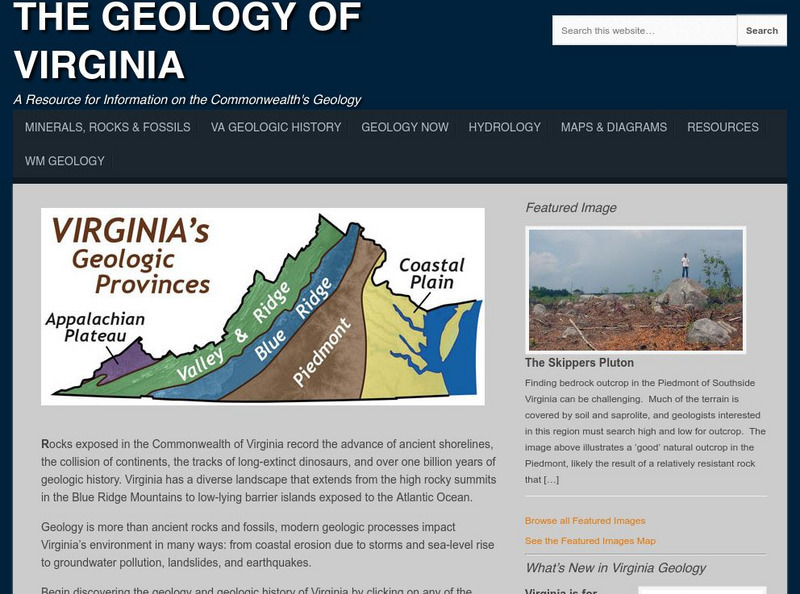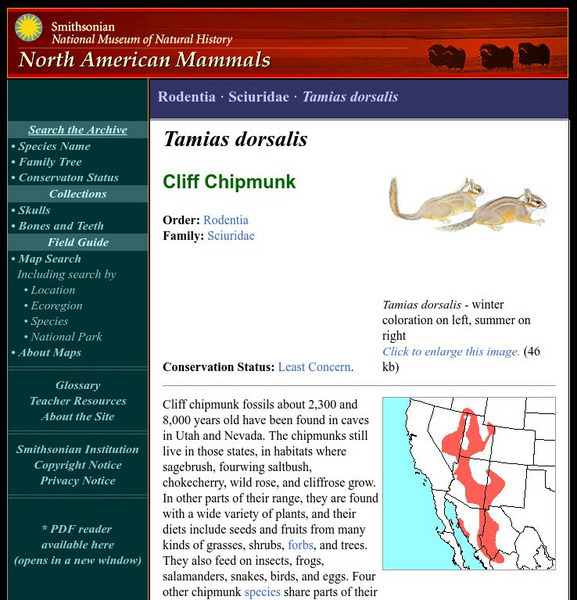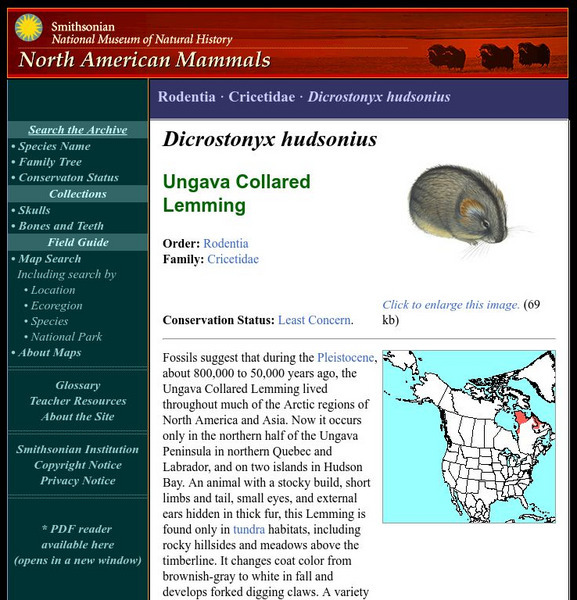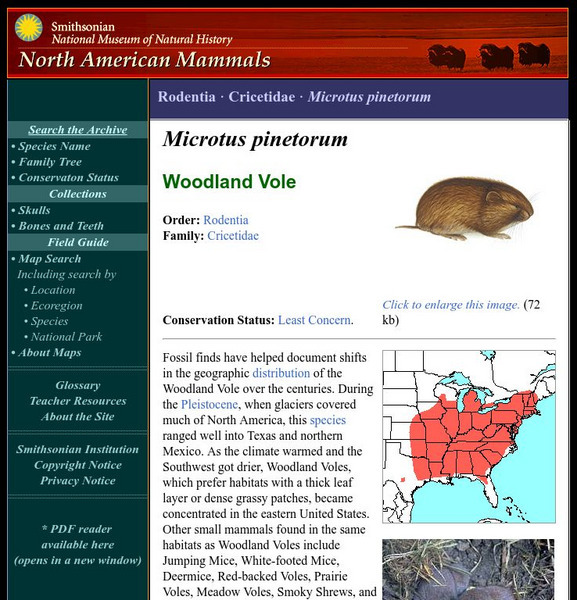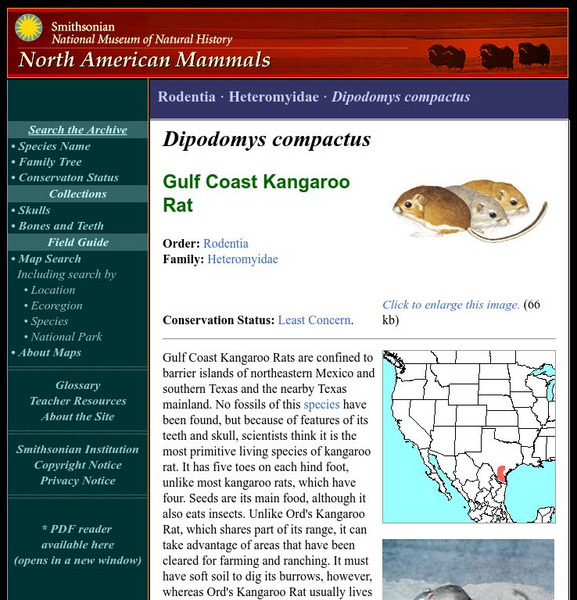John Wiley & Sons
Wiley: Earth Through Time: Life of the Paleozoic: Phylum Chordata
Learn about the evolution of life in the Paleozoic Era based on fossil evidence of the five classes of fishes. Read about the role these chordates played in the evolution of tetrapods.
Australian Museum
Australian Museum: Fishes: Coelacanth
An article on modern-day discoveries about the prehistoric coelacanth fish. Read about the geographic distribution, classification, fossil record, and economic and social impacts of the animal.
Other
College of William and Mary: The Geology of Virginia
Information about the land forms of Virginia. Explore each region of the state and read about the ancient shorelines, active volcanoes, colliding continents, and dinosaur fossils.
Australian Broadcasting Corporation
Australian Broadcasting Corporation: Walking With Dinosaurs: Fact File: Ornithocheirus
Ornithocheirus was a reptile from the Early Cretaceous period, and this resource highlights some of the facts revealed by this large pterosaur's fossilized remains. View a video and several images showing close-ups of its body parts, and...
Curated OER
Fossil
A 100-million year old fossil was found in China. It was thought to have been a bird similar to a loon. Read more about this fantastic find.
Other
Travel Montana: Montana Kids: Maiasaur
The Maiasaur is a kind of hadrosaur, a dinosaur that lived in the Upper Cretaceous Period. Much of what is known about the Maiasaur came from the fossils found at Egg Mountain in Montana. Jack Horner, a well known paleontologist,...
Children's Museum
Dinosphere: Dino Profiles: Meet the Hypacrosaur Family
What is a Hypacrosaurus and how did they eat, live, and protect themselves against predators? Paleontologists have learned answers to these questions and others by looking Hypacrosaurus fossils. Read facts about this herbivorous...
Australian Broadcasting Corporation
Australian Broadcasting Corporation: News in Science: Scientists Catch the Early Bird
A 100-million year old fossil was found in China. It was thought to have been a bird similar to a loon. Read more about this fantastic find.
Australian Broadcasting Corporation
Australian Broadcasting Corporation: Walking With Dinosaurs: Fact Files: Didelphodon
Read about the Didelphodon, a marsupial from the Mesozoic era and Cretaceous period. Learn what fossils have taught us about their habitat, diet, and senses, and view an animated image showing how this mammal may have moved.
Mocomi & Anibrain Digital Technologies
Mocomi: Dinosaur Facts and Information
Read a brief history of dinosaurs and how fossils are formed. Learn about the three main dinosaur periods, plant-eating dinosaurs, meat-eating dinosaurs, the end of dinosaurs, and other interesting facts.
Other
Black Hills Institute of Geological Research: Unearthing T. Rex
Follow the steps of paleontologists as they excavate Tyrannosaurus bones. This project took place in 2004 but there is plenty of useful information on the website for learning more about the T. Rex. Such as, how do you tell a male from a...
Curated OER
Harappan Civilization Haryana, Rajasthan & Beyond?
This web-article overviews the excavational findings at the Harappan village of Rakhigarhi. Read about various relics, fossils, and constructions which are "Expected to reveal information on the Harappa and Mohenjodaro civilizations."
Curated OER
Harappan Civilization Haryana, Rajasthan & Beyond?
This web-article overviews the excavational findings at the Harappan village of Rakhigarhi. Read about various relics, fossils, and constructions which are "Expected to reveal information on the Harappa and Mohenjodaro civilizations."
Curated OER
Harappan Civilization Haryana, Rajasthan & Beyond?
This web-article overviews the excavational findings at the Harappan village of Rakhigarhi. Read about various relics, fossils, and constructions which are "Expected to reveal information on the Harappa and Mohenjodaro civilizations."
Curated OER
Artist's Reconstruction
A 100-million year old fossil was found in China. It was thought to have been a bird similar to a loon. Read more about this fantastic find.
Australian Broadcasting Corporation
Australian Broadcasting Corporation: Walking With Dinosaurs: Fact File: Ophthalmosaurus
Read information about the dolphin-shaped opthalmosaurus, and learn what fossil evidence tells us about this marine dinosaur's hunting, anatomy, and young. View a listing of quick facts about the opthalmosaurus' size and diet, and launch...
Australian Broadcasting Corporation
Australian Broadcasting Corporation: Walking With Dinosaurs: Fact File: Diplodocus
Diplodocus, a sauropod, "was the longest of the land animals" and its fossilized remains tell us much about its body type, weight, and diet. Read facts about this dinosaur and view several images showing what it looked like while alive.
PBS
Pbs: Evolution: Origins of Humankind: Homo Sapiens
Read a description of Homo sapiens as a species, learn about the variety of Homo sapiens fossils that have been found, and discover evidence of the culture of these early people.
Australian Broadcasting Corporation
Australian Broadcasting Corporation: Walking With Dinosaurs: Fact File: Ornitholestes
A brief look at what fossilized remains teach us about Ornitholestes, a carnivorous dinosaur "very closely related to the evolutionary line that produced the birds." Read facts about its size, anatomy, and diet, and view images showing...
Smithsonian Institution
National Museum of Natural History: American Mammals: Cliff Chipmunk
Cliff chipmunk fossils about 2,300 and 8,000 years old have been found in caves in Utah and Nevada. The chipmunks still live in those states, in habitats where sagebrush, fourwing saltbush, chokecherry, wild rose, and cliffrose grow....
Smithsonian Institution
National Museum of Natural History: American Mammals: Ungava Collared Lemming
Fossils suggest that during the Pleistocene, about 800,000 to 50,000 years ago, the Ungava Collared Lemming lived throughout much of the Arctic regions of North America and Asia. Now it occurs only in the northern half of the Ungava...
Smithsonian Institution
National Museum of Natural History: American Mammals: Woodland Vole
Fossil finds have helped document shifts in the geographic distribution of the Woodland Vole over the centuries. During the Pleistocene, when glaciers covered much of North America, this species ranged well into Texas and northern...
Smithsonian Institution
National Museum of Natural History: American Mammals: Gulf Coast Kangaroo Rat
Gulf Coast Kangaroo Rats are confined to barrier islands of northeastern Mexico and southern Texas and the nearby Texas mainland. No fossils of this species have been found, but because of features of its teeth and skull, scientists...


